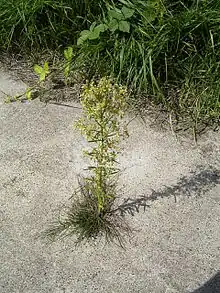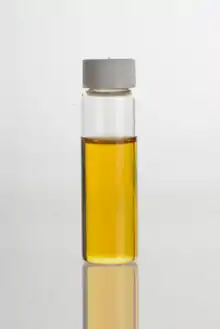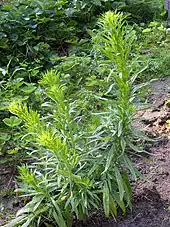Erigeron canadensis
Erigeron canadensis (synonym Conyza canadensis) is an annual plant native throughout most of North America and Central America. It is also widely naturalized in Eurasia and Australia.[2] Common names include horseweed, Canadian horseweed, Canadian fleabane, coltstail, marestail, and butterweed. It was the first weed to have developed glyphosate resistance, reported in 2001 from Delaware.[3]
| Erigeron canadensis | |
|---|---|
 | |
| In the Netherlands in 2004 | |
| Scientific classification | |
| Kingdom: | Plantae |
| Clade: | Tracheophytes |
| Clade: | Angiosperms |
| Clade: | Eudicots |
| Clade: | Asterids |
| Order: | Asterales |
| Family: | Asteraceae |
| Genus: | Erigeron |
| Species: | E. canadensis |
| Binomial name | |
| Erigeron canadensis | |
| Synonyms[1] | |
| |

Description
Erigeron canadensis is an annual plant growing to 1.5 m (60 in) tall, with sparsely hairy stems. The leaves are unstalked, slender, 2–10 centimetres (0.79–3.94 in) long, and up to 1 cm (0.4 inches) across, with a coarsely toothed margin. They grow in an alternate spiral up the stem and the lower ones wither early. The flowers are produced in dense inflorescences 1 cm in diameter. Each individual flower has a ring of white or pale purple ray florets and a centre of yellow disc florets. The fruit is a cypsela tipped with dirty white down.[4]
E. canadensis can easily be confused with Erigeron sumatrensis, which may grow to a height of 2 m, and the more hairy Erigeron bonariensis, which does not exceed 1 m (40 in). E. canadensis is distinguished by bracts that have a brownish inner surface and no red dot at the tip, and are free (or nearly free) of the hairs found on the bracts of the other species.[5][6][7]
Distribution and habitat
Horseweed originated in North America and is very widespread there,[2] but has spread to inhabited areas of most of the temperate zone of Asia,[8] Europe,[4][9] and Australia.[10] It is found in Britain from northern Scotland to Cornwall, growing as a weed of arable land and man-made environments. It considered invasive in China.[11]
Weed status
Horseweed is commonly considered a weed, and in Ohio, it has been declared a noxious weed.[12] It can be found in fields, meadows, and gardens throughout its native range. Horseweed infestations have reduced soybean yields by as much as 83%. It is an especially problematic weed in no-till agriculture, as it is often resistant to glyphosate[3] and other herbicides.[13] Farmers are advised to include 2,4-D or dicamba in a burndown application prior to planting to control horseweed.
Uses
The Zuni people insert the crushed flowers of E. canadensis var. canadensis into the nostrils to cause sneezing, relieving rhinitis.[14] Other Native Americans used a preparation of the plant's leaves to treat sore throat and dysentery.[15] A tincture can be made from the dried flowering tops of the plants.
Horseweed is a preferable material for use in the hand drill-method of making friction fire.[4]
References
- "Erigeron canadensis L." Plants of the World Online. Royal Botanic Gardens, Kew. Retrieved 2020-08-16.
- Biota of North America Program, 2014 county distribution map, Erigeron canadensis
- VanGessel, Mark J. (2001). "Glyphosate-resistant horseweed from Delaware". Weed Science. 49 (6): 703–705. doi:10.1614/0043-1745(2001)049[0703:RPRHFD]2.0.CO;2. JSTOR 4046416.
- "Canadian Fleabane: Conyza canadensis". NatureGate. Retrieved 2013-12-31.
- Conyza sumatrensis, International Environmental Weed Foundation
- Green, Deane. "Horseweed, Marestail". Retrieved 2014-08-09.
- Flora of North America, Conyza canadensis (Linnaeus) Cronquist, Bull. Torrey Bot. Club. 70: 632. 1943. Vergerette du Canada
- Flora of China, Erigeron canadensis Linnaeus, Sp. Pl. 2: 863. 1753. 小蓬草 xiao peng cao
- Altervista Flora Italiana, Cespica canadese, avoadinha, Berufkraut, Erigeron canadensis L. includes photos and European distribution map
- Atlas of Living Australia, Conyza canadensis (L.) Cronquist Canadian Fleabane
- Wu, Bingde; Zhang, Huanshi; Jiang, Kun; Zhou, Jiawei; Wang, Congyan (2019). "Erigeron canadensis affects the taxonomic and functional diversity of plant communities in two climate zones in the North of China". Ecological Research. 34 (4): 535–547. doi:10.1111/1440-1703.12024.
- "Erigeron canadensis". Germplasm Resources Information Network (GRIN). Agricultural Research Service (ARS), United States Department of Agriculture (USDA). Retrieved 2017-12-18.
- Kruger, Greg R.; Davis, Vince M.; Weller, Stephen C.; Johnson, William G. (2010). "Growth and Seed Production of Horseweed (Conyza canadensis) Populations after Exposure to Postemergence 2,4-D". Weed Science. 58 (4): 413–419. doi:10.1614/WS-D-10-00022.1. S2CID 55366555.
- Stevenson, Matilda Coxe 1915 Ethnobotany of the Zuni Indians. SI-BAE Annual Report #30 (p.55).
- Niering, William A.; Olmstead, Nancy C. (1985) [1979]. The Audubon Society Field Guide to North American Wildflowers, Eastern Region. Knopf. p. 377. ISBN 0-394-50432-1.
External links
| Wikimedia Commons has media related to Erigeron canadensis. |

